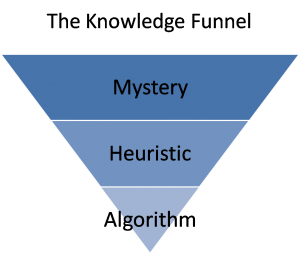 A few weeks ago I received “The Design of Business” by Roger Martin in the mail. “The Design of Business” is a relatively short, easy, and pleasant read.
A few weeks ago I received “The Design of Business” by Roger Martin in the mail. “The Design of Business” is a relatively short, easy, and pleasant read.
The main premise of the book is that our organizations, and the business schools that fill out their top leadership ranks, are too focused on analytical thinking at the expense of intuitive thinking. This focus creates too much emphasis on reliability at the expense of validity.
“The most successful businesses in the years to come will balance analytical mastery and intuitive originality in a dynamic interplay that I call design thinking.” – Roger Martin
One of the key concepts of the book is the introduction of the Knowledge Funnel – a visual element that shows how knowledge progresses from mysteries to heuristics to algorithms. It all begins with a question at the top of the funnel, and at each stage transition, knowledge and execution can typically be transferred to lower cost labor (and possibly handled by a computer when they reach the algorithm level).
 At the same time, there are other tensions in our organizations that managers in the era of the creative economy will have to become attuned to, and these include managing an appropriate balance between exploitation and exploration and not falling victim to the false certainty of the past when making business development decisions.
At the same time, there are other tensions in our organizations that managers in the era of the creative economy will have to become attuned to, and these include managing an appropriate balance between exploitation and exploration and not falling victim to the false certainty of the past when making business development decisions.
Ultimately, the exploration of the mysteries at the top of the knowledge funnel and exploitation of the algrithms at the bottom of the funnel are equally important. Companies that focus too much on one, at the expense of the other, risk their very future.
Creating a design thinking organization is not easy, and several pages are devoted to describing the struggles of A.G. Lafley and Claudia Kotchka in transforming P&G;’s organizational culture to be more design-centric.
In addition to other examples of organizations pushing themselves more towards design thinking, there is also a great deal of focus in the book on the transformation of mysteries into heuristics and heuristics into algorithms.
Overall, the book is another way of looking at the challenge facing innovators everywhere who are looking to embed design or innovation (or both) into their organization.
So, are you ready to tackle the challenge of achieving a balance of analytical thinking with intuitive thinking in your organization?
My interview with “The Design of Business” author Roger Martin can be found here.
![]() Sign up here to get Human-Centered Change & Innovation Weekly delivered to your inbox every week.
Sign up here to get Human-Centered Change & Innovation Weekly delivered to your inbox every week.
Pingback: Balancing Intuition with Analysis | Human-Centered Change and Innovation
Pingback: Innovation a Prisoner of Inductive and Deductive Logic | Human-Centered Change and Innovation